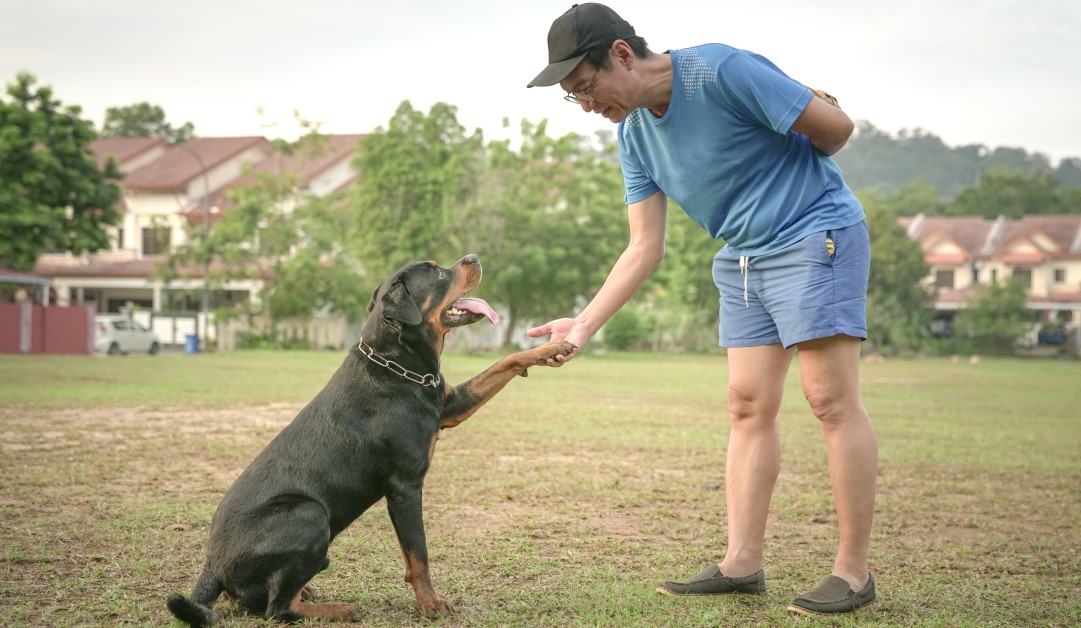Understanding Pack Behavior in Dogs
Dogs are social creatures that follow a dog pack hierarchy, meaning every dog understands his or her place in the pack.

Misunderstanding dog pack behavior can result in behavioral issues that last throughout the animal’s life. Dogs have a strict social system that establishes the roles of each pack member. There is the dominant or “alpha” dog, the neutral “beta” dog, and the submissive “omega” dog. The dogs in these roles can be either male or female.
When you bring a dog into your home, you and your family members also become part of your pet’s pack. It is up to you to become the leader of the pack, and if you fail to do so, your dog may attempt to fill this role. Establishing groundwork is essential when bringing a new dog into the home to prevent unwanted pack behaviors like aggression.
Dog Pack Dynamics
The dog pack hierarchy can be difficult to understand, especially if you have never owned dogs before. Dogs do not live in packs for hunting or survival purposes like other animals. Instead, their social dynamics are more comparable to those of humans.
Domesticated dogs that are introduced to a household are fairly adaptable to a variety of living arrangements. In the wild, a dog pack would generally consist of between eight and 15 wild dogs or wolves. Dogs in human households can form packs with just a few members.
Although dogs do not see their humans as other dogs, they do see them as part of their pack. Ideally, a dog should see its owner as the pack leader and exhibit appropriate dog pack behavior. Problems can occur when a dog assumes the role of alpha.
Unwanted Alpha Behavior in Dogs
While our beloved pets can be quite demanding from time to time, there is a difference between a pet that craves affection and one that is establishing alpha status over its owner. When a dog attempts to take over leadership in the home, it may start to display alpha behavior.
Some signs that indicate that you are no longer the pack leader include the following:
- Your dog growls at you if you go near his food or toys.
- Your dog stares into your eyes and does not turn away.
- Your dog claims a certain spot on the sofa or bed.
- Your dog pushes past you to enter a doorway first.
- Your dog pulls on the leash and walks ahead of you.
- Your dog marks the inside of the home, claiming ownership.
- Your dog does not obey your commands.
- Your dog jumps on you after continually being corrected.
Alpha behavior in dogs may be subtle at first and grow over time as your pet continues to test its boundaries. Establishing yourself as the pack leader during puppyhood (if possible) is key to preventing behavioral problems going forward. However, even older dogs can learn their place in the dog pack hierarchy if properly and consistently trained.
Changing Unwanted Dog Pack Behavior
Dogs naturally seek out the leader of the pack. If the human of the household does not assume this position, the dog will take the alpha role and behavioral problems may subsequently occur. Stepping up to become the pack leader in your home not only helps prevent unwanted dominant behavior but also helps your dog live a less stressful life.
The following tips and strategies can help you change unwanted dog pack behavior by showing your pet that you are the alpha:
1. Practice Basic Obedience
Unwanted behaviors in dogs often stem from a lack of training. If your dog does not understand basic commands like “come” or “sit,” then your pet does not possess the basic obedience needed to ward off bad behaviors.
2. Maintain Eye Contact
Your dog needs to know that you are the alpha. This can be achieved in a variety of ways, such as maintaining eye contact when talking to the dog. Use a firm voice when speaking to your pet and exude confidence to show your pet that you are the alpha.
3. Perform Leash Training
Dogs that know their place in the dog pack hierarchy will properly walk on a leash. This means that the dog walks alongside or slightly behind their owner, never in front or while pulling at the leash. Other bad behaviors, such as lunging or barking at other people or animals while out for a walk, should also not be tolerated.
4. Control Your Household
Dominant dogs often take advantage of their freedom in and out of the house. Does your dog climb on the furniture and sleep in your bed? Does he beg at the dinner table for scraps? These behaviors are your pet’s way of asserting his dominance. Take control of your household and only allow your pet freedom with your permission.
5. Be Consistent with Training
The most important thing you can do when attempting to alter the dog pack hierarchy is to be consistent. If you are firm with your dog one day but allow him to behave poorly without consequence the next day, it can send mixed signals. When training your pet, it is important to be consistent.
In some cases, at-home training by a non-professional is not enough to resolve behavioral problems in highly aggressive or territorial dogs. It may be necessary to seek the guidance of a professional dog trainer or animal behaviorist.
Ready to start saving money on pet wellness care?
Then take a look at Mint Wellness, the pet wellness plan that provides fast reimbursement on routine pet care. Save on vaccinations, wellness exams, preventatives, dental, and more!
Learn More


